Analys
Another geopolitical jolt for oil markets?


Oil prices surged in the first week of the new year following a US airstrike which killed Qassem Soleimani, the head of the Iranian Revolutionary Guards’ overseas forces. Tensions are rife in the region as the Iraqi parliament has since voted to expel US military from their soil prompting US President Trump to threaten sanctions against the country. Brent, which was trading at around $59/barrel at the end of Q3 last year, was hovering around $69/barrel on 8 Jan 2020.
In our annual outlook for 2020 published last month, we stressed that oil markets have not been pricing at a reasonable level of geopolitical risk premium given the fragility in the Middle East. In this blog, we will review why we believe that to be the case, analyse what is being priced in by oil futures curves and discuss where oil markets may head from here.
The missing geopolitical risk premium
Brent prices were trading around $85/barrel in October 2018 when the US announced sanctions against Iran. Since then, prices have fallen considerably as markets have been fixated on demand growth destruction on account of lukewarm global economic growth. But the period in between has not been devoid of volatility. What has been most curious is how quickly oil prices have reset after spiking sharply every time a ‘geopolitical’ event has taken place. The most vivid example of this came in September 2019 when Saudi oil facilities were hit by a drone attack raising major oil supply concerns among global markets. Prices fell back quickly when Saudi authorities assured markets that the damage was well within their control (See Figure 1). We believe a reasonable level of geopolitical risk premium has been missing from oil prices given the tensions in the region in recent months. Recent price action may be an early sign that markets are beginning to price in this premium to take us closer to a fairer price range for Brent around $70-$75/barrel.
Figure 1: Geopolitical risk premium has vanished from oil prices
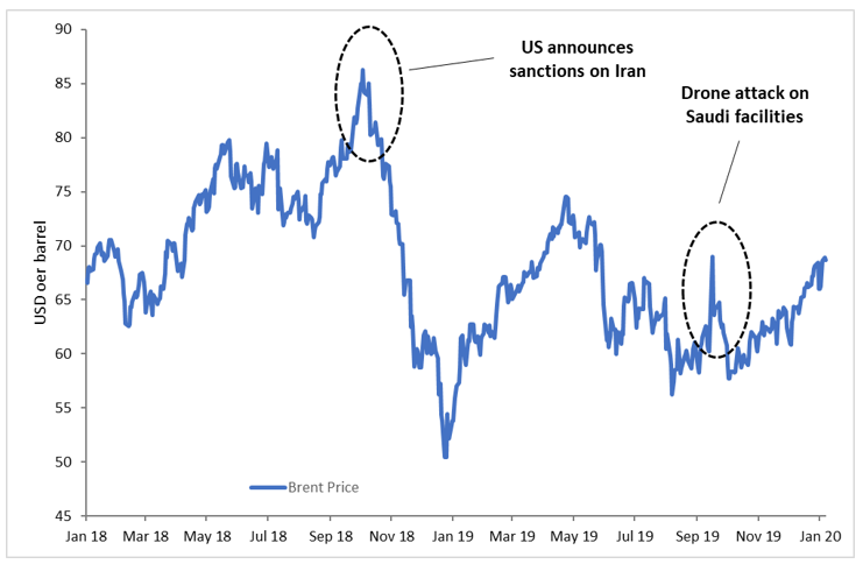
What the backwardated futures curves tell us
A backwardated futures curve typically indicates that people are willing to pay more for prompt delivery than wait, suggesting near-term tightness for the commodity. Brent and WTI curves have become considerably more backwardated in the last three months (See Figure 2). Front-end prices started rising in October last year when markets started to price in further supply cuts by the Organisation of the Petroleum Exporting Countries (OPEC). OPEC and its allies, known as OPEC+ delivered by cutting supplies by 0.5mn barrels per day to bring total cuts to 1.7mn barrels per day compared to October 2018 levels. The steep backwardation in the curves, however, tells us that oil futures are pricing in the following:
- Supply will be plentiful over longer maturities as any tightness from a near-term shock may be offset by more sources of oil opening up (e.g. OPEC could loosen supply)
- Geopolitical risks are gradually getting priced in making the curve steeper at the front end.
If geopolitical tensions persist, or indeed escalate, oil prices are likely to experience upward pressure. Front end prices for oil can be volatile and, in recent months, oil curves have become more backwardated following geopolitical events before flattening out again. To infer that a geopolitical risk premium has been reasonably priced in, the backwardation would need to persist while the risks remain alive.
Figure 2: Brent and WTI curves have become more backwardated
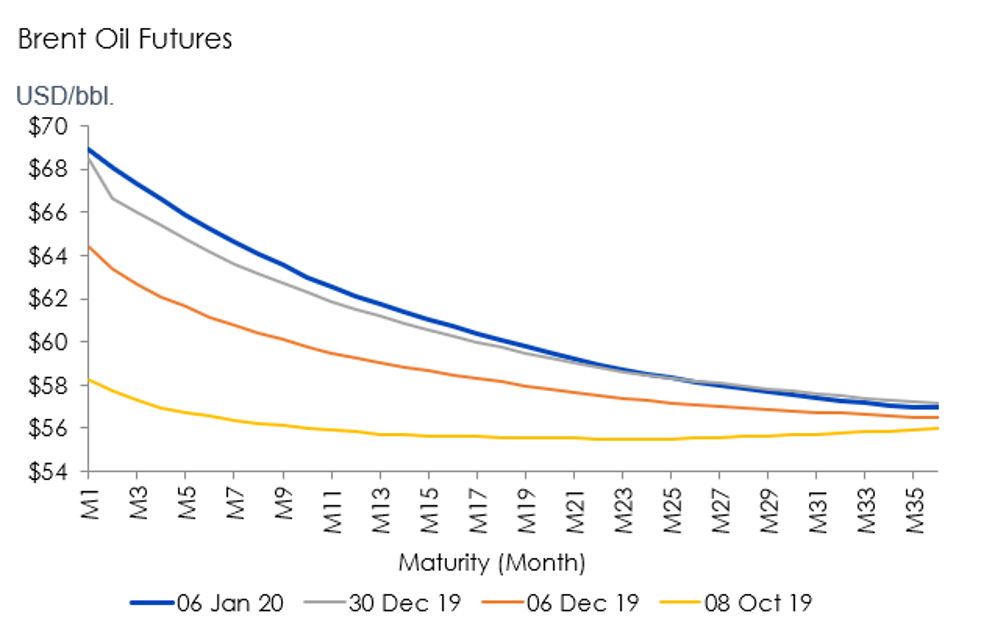
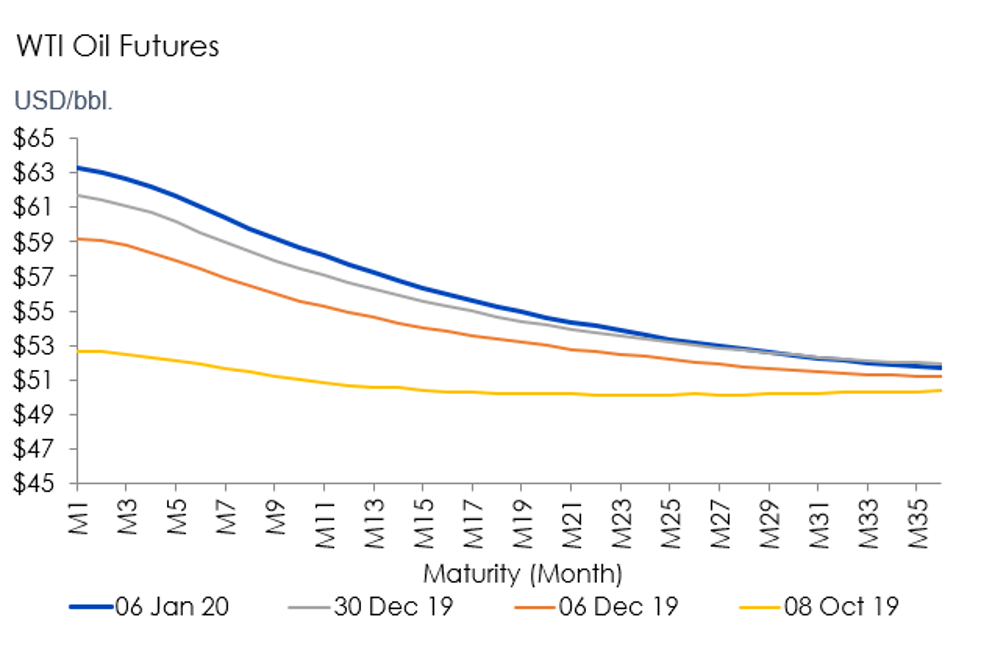
The events from last week have had a slightly bigger impact on Brent, which is a more international oil benchmark, compared to WTI, which tends to be impacted more by US supply and demand dynamics.
Where do we go from here?
Oil markets are likely to remain reactive to developments between US and Iran. An outright conflict between the two could result in a major supply shock and the Strait of Hormuz could become inaccessible to a third of global oil volume which currently flows through it. Equally, a de-escalation in the most recent tensions may calm market nerves and lower oil prices yet again as they have following other geopolitical incidents in the region over the last year.
Given the uncertainty and the stakes, rationality would dictate that markets bake a geopolitical risk premium into oil prices until we see a meaningful resolution of major issues between the US and Iran. As tensions persist, markets will likely become more cognizant of this and oil prices will be supported. If however markets become complacent yet again and the premium erodes before all issues are resolved, oil could serve as a very good hedge for geopolitical risks as prices theoretically would rise whenever a geopolitical ‘event’ takes place.
A futures curve is said to be backwardated when its spot or cash price is higher than the forward price. The opposite situation is called contango in which the forward price is higher than the spot or cash price.
This material is prepared by WisdomTree and its affiliates and is not intended to be relied upon as a forecast, research or investment advice, and is not a recommendation, offer or solicitation to buy or sell any securities or to adopt any investment strategy. The opinions expressed are as of the date of production and may change as subsequent conditions vary. The information and opinions contained in this material are derived from proprietary and non-proprietary sources. As such, no warranty of accuracy or reliability is given and no responsibility arising in any other way for errors and omissions (including responsibility to any person by reason of negligence) is accepted by WisdomTree, nor any affiliate, nor any of their officers, employees or agents. Reliance upon information in this material is at the sole discretion of the reader. Past performance is not a reliable indicator of future performance.
Analys
Tightening fundamentals – bullish inventories from DOE

The latest weekly report from the US DOE showed a substantial drawdown across key petroleum categories, adding more upside potential to the fundamental picture.

Commercial crude inventories (excl. SPR) fell by 5.8 million barrels, bringing total inventories down to 415.1 million barrels. Now sitting 11% below the five-year seasonal norm and placed in the lowest 2015-2022 range (see picture below).
Product inventories also tightened further last week. Gasoline inventories declined by 2.1 million barrels, with reductions seen in both finished gasoline and blending components. Current gasoline levels are about 3% below the five-year average for this time of year.
Among products, the most notable move came in diesel, where inventories dropped by almost 4.1 million barrels, deepening the deficit to around 20% below seasonal norms – continuing to underscore the persistent supply tightness in diesel markets.
The only area of inventory growth was in propane/propylene, which posted a significant 5.1-million-barrel build and now stands 9% above the five-year average.
Total commercial petroleum inventories (crude plus refined products) declined by 4.2 million barrels on the week, reinforcing the overall tightening of US crude and products.
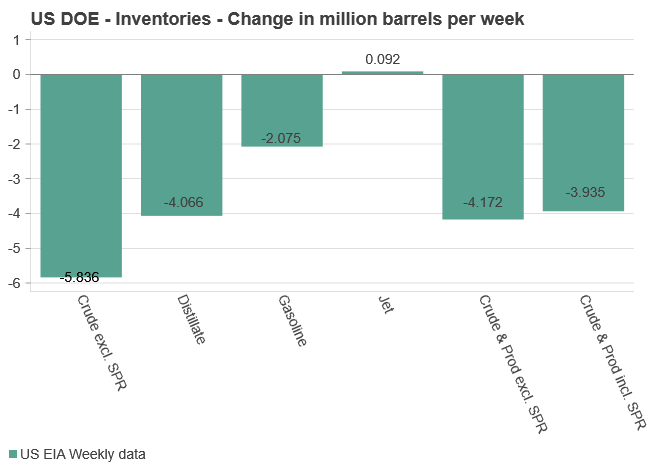
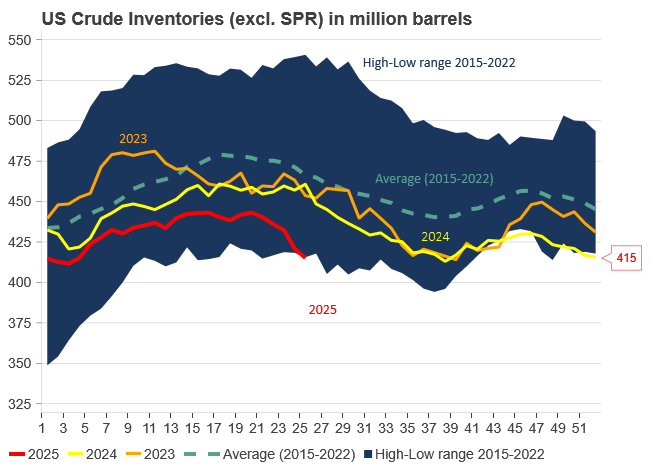
Analys
Bombs to ”ceasefire” in hours – Brent below $70

A classic case of “buy the rumor, sell the news” played out in oil markets, as Brent crude has dropped sharply – down nearly USD 10 per barrel since yesterday evening – following Iran’s retaliatory strike on a U.S. air base in Qatar. The immediate reaction was: “That was it?” The strike followed a carefully calibrated, non-escalatory playbook, avoiding direct threats to energy infrastructure or disruption of shipping through the Strait of Hormuz – thus calming worst-case fears.

After Monday morning’s sharp spike to USD 81.4 per barrel, triggered by the U.S. bombing of Iranian nuclear facilities, oil prices drifted sideways in anticipation of a potential Iranian response. That response came with advance warning and caused limited physical damage. Early this morning, both the U.S. President and Iranian state media announced a ceasefire, effectively placing a lid on the immediate conflict risk – at least for now.
As a result, Brent crude has now fallen by a total of USD 12 from Monday’s peak, currently trading around USD 69 per barrel.
Looking beyond geopolitics, the market will now shift its focus to the upcoming OPEC+ meeting in early July. Saudi Arabia’s decision to increase output earlier this year – despite falling prices – has drawn renewed attention considering recent developments. Some suggest this was a response to U.S. pressure to offset potential Iranian supply losses.
However, consensus is that the move was driven more by internal OPEC+ dynamics. After years of curbing production to support prices, Riyadh had grown frustrated with quota-busting by several members (notably Kazakhstan). With Saudi Arabia cutting up to 2 million barrels per day – roughly 2% of global supply – returns were diminishing, and the risk of losing market share was rising. The production increase is widely seen as an effort to reassert leadership and restore discipline within the group.
That said, the FT recently stated that, the Saudis remain wary of past missteps. In 2018, Riyadh ramped up output at Trump’s request ahead of Iran sanctions, only to see prices collapse when the U.S. granted broad waivers – triggering oversupply. Officials have reportedly made it clear they don’t intend to repeat that mistake.
The recent visit by President Trump to Saudi Arabia, which included agreements on AI, defense, and nuclear cooperation, suggests a broader strategic alignment. This has fueled speculation about a quiet “pump-for-politics” deal behind recent production moves.
Looking ahead, oil prices have now retraced the entire rally sparked by the June 13 Israel–Iran escalation. This retreat provides more political and policy space for both the U.S. and Saudi Arabia. Specifically, it makes it easier for Riyadh to scale back its three recent production hikes of 411,000 barrels each, potentially returning to more moderate increases of 137,000 barrels for August and September.
In short: with no major loss of Iranian supply to the market, OPEC+ – led by Saudi Arabia – no longer needs to compensate for a disruption that hasn’t materialized, especially not to please the U.S. at the cost of its own market strategy. As the Saudis themselves have signaled, they are unlikely to repeat previous mistakes.
Conclusion: With Brent now in the high USD 60s, buying oil looks fundamentally justified. The geopolitical premium has deflated, but tensions between Israel and Iran remain unresolved – and the risk of missteps and renewed escalation still lingers. In fact, even this morning, reports have emerged of renewed missile fire despite the declared “truce.” The path forward may be calmer – but it is far from stable.
Analys
A muted price reaction. Market looks relaxed, but it is still on edge waiting for what Iran will do

Brent crossed the 80-line this morning but quickly fell back assigning limited probability for Iran choosing to close the Strait of Hormuz. Brent traded in a range of USD 70.56 – 79.04/b last week as the market fluctuated between ”Iran wants a deal” and ”US is about to attack Iran”. At the end of the week though, Donald Trump managed to convince markets (and probably also Iran) that he would make a decision within two weeks. I.e. no imminent attack. Previously when when he has talked about ”making a decision within two weeks” he has often ended up doing nothing in the end. The oil market relaxed as a result and the week ended at USD 77.01/b which is just USD 6/b above the year to date average of USD 71/b.

Brent jumped to USD 81.4/b this morning, the highest since mid-January, but then quickly fell back to a current price of USD 78.2/b which is only up 1.5% versus the close on Friday. As such the market is pricing a fairly low probability that Iran will actually close the Strait of Hormuz. Probably because it will hurt Iranian oil exports as well as the global oil market.
It was however all smoke and mirrors. Deception. The US attacked Iran on Saturday. The attack involved 125 warplanes, submarines and surface warships and 14 bunker buster bombs were dropped on Iranian nuclear sites including Fordow, Natanz and Isfahan. In response the Iranian Parliament voted in support of closing the Strait of Hormuz where some 17 mb of crude and products is transported to the global market every day plus significant volumes of LNG. This is however merely an advise to the Supreme leader Ayatollah Ali Khamenei and the Supreme National Security Council which sits with the final and actual decision.
No supply of oil is lost yet. It is about the risk of Iran closing the Strait of Hormuz or not. So far not a single drop of oil supply has been lost to the global market. The price at the moment is all about the assessed risk of loss of supply. Will Iran choose to choke of the Strait of Hormuz or not? That is the big question. It would be painful for US consumers, for Donald Trump’s voter base, for the global economy but also for Iran and its population which relies on oil exports and income from selling oil out of that Strait as well. As such it is not a no-brainer choice for Iran to close the Strait for oil exports. And looking at the il price this morning it is clear that the oil market doesn’t assign a very high probability of it happening. It is however probably well within the capability of Iran to close the Strait off with rockets, mines, air-drones and possibly sea-drones. Just look at how Ukraine has been able to control and damage the Russian Black Sea fleet.
What to do about the highly enriched uranium which has gone missing? While the US and Israel can celebrate their destruction of Iranian nuclear facilities they are also scratching their heads over what to do with the lost Iranian nuclear material. Iran had 408 kg of highly enriched uranium (IAEA). Almost weapons grade. Enough for some 10 nuclear warheads. It seems to have been transported out of Fordow before the attack this weekend.
The market is still on edge. USD 80-something/b seems sensible while we wait. The oil market reaction to this weekend’s events is very muted so far. The market is still on edge awaiting what Iran will do. Because Iran will do something. But what and when? An oil price of 80-something seems like a sensible level until something do happen.
-

 Nyheter3 veckor sedan
Nyheter3 veckor sedanMahvie Minerals växlar spår – satsar fullt ut på guld
-

 Nyheter4 veckor sedan
Nyheter4 veckor sedanUppgången i oljepriset planade ut under helgen
-

 Nyheter4 veckor sedan
Nyheter4 veckor sedanLåga elpriser i sommar – men mellersta Sverige får en ökning
-

 Nyheter3 veckor sedan
Nyheter3 veckor sedanJonas Lindvall är tillbaka med ett nytt oljebolag, Perthro, som ska börsnoteras
-

 Analys3 veckor sedan
Analys3 veckor sedanA muted price reaction. Market looks relaxed, but it is still on edge waiting for what Iran will do
-

 Nyheter3 veckor sedan
Nyheter3 veckor sedanOljan, guldet och marknadens oroande tystnad
-

 Analys4 veckor sedan
Analys4 veckor sedanVery relaxed at USD 75/b. Risk barometer will likely fluctuate to higher levels with Brent into the 80ies or higher coming 2-3 weeks
-

 Nyheter3 veckor sedan
Nyheter3 veckor sedanDomstolen ger klartecken till Lappland Guldprospektering















